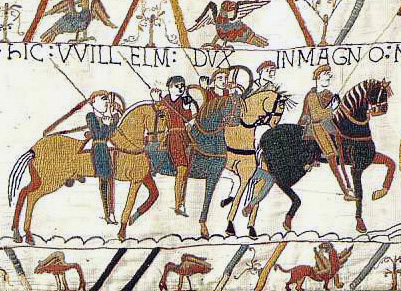| Revision as of 11:25, 14 October 2004 editMatt Crypto (talk | contribs)23,089 editsm fmt mk II← Previous edit | Revision as of 22:45, 31 October 2004 edit undoThe stuart (talk | contribs)Extended confirmed users, Pending changes reviewers8,587 editsNo edit summaryNext edit → | ||
| Line 5: | Line 5: | ||
| The tapestry is ] long and 0.5 metres wide. It has 58 scenes, which portray in detail the progress of ] to the throne. It is sometimes said to have been made by William's queen, ], and her ladies. Indeed, in France it is known as "La Tapisserie de la Reine Mathilde" (Tapestry of Queen Mathilda). However, it was probably made in a workshop on the orders of ], who was William's half-brother. | The tapestry is ] long and 0.5 metres wide. It has 58 scenes, which portray in detail the progress of ] to the throne. It is sometimes said to have been made by William's queen, ], and her ladies. Indeed, in France it is known as "La Tapisserie de la Reine Mathilde" (Tapestry of Queen Mathilda). However, it was probably made in a workshop on the orders of ], who was William's half-brother. | ||
| The misidentification of ] in the tapestry has led to the widespread but incorrect idea that Harold was killed by an arrow striking his eye. The tapestry also contains a representation of a comet which is likely to be ]. While political propaganda or personal emphasis may have somewhat distorted the historic accuracy of the story, the Bayeux tapestry presents a unique visual document of medieval arms, apparel, and other objects. However, it has been noted that the warriors are depicted fighting with bare hands, while other sources indicate the general use of ] in battle and hunt. | The misidentification of ] in the tapestry has led to the widespread but incorrect idea that Harold was killed by an arrow striking his eye. The tapestry also contains a representation of a comet, which is likely to be ], that appeared around the corronation of King Harold. While political propaganda or personal emphasis may have somewhat distorted the historic accuracy of the story, the Bayeux tapestry presents a unique visual document of medieval arms, apparel, and other objects unlike any other artifact surviving from this period that has been found. However, it has been noted that the warriors are depicted fighting with bare hands, while other sources indicate the general use of ] in battle and hunt. | ||
| The embroiderers used wool which had been tinted with vegetable dyes. The colours of muted brick, rust, mustard yellow, olive-green, dark brown and off-white can be found in cloth traditionally woven in the region. | The embroiderers used wool which had been tinted with vegetable dyes. The colours of muted brick, rust, mustard yellow, olive-green, dark brown and off-white can be found in cloth traditionally woven in the region. | ||
Revision as of 22:45, 31 October 2004

The Bayeux tapestry (French: Tapisserie de Bayeux) is not actually a tapestry (that is, a weaving), but is embroidery, and dates from 1077. It is currently to be found in a special museum in the town of Bayeux in Normandy. It was made in England, probably in Kent, after the Norman conquest of 1066, and commemorates the events leading up to the Battle of Hastings.
The tapestry is 70 metres long and 0.5 metres wide. It has 58 scenes, which portray in detail the progress of William I of England to the throne. It is sometimes said to have been made by William's queen, Matilda of Flanders, and her ladies. Indeed, in France it is known as "La Tapisserie de la Reine Mathilde" (Tapestry of Queen Mathilda). However, it was probably made in a workshop on the orders of Odo, Bishop of Bayeux, who was William's half-brother.
The misidentification of Harold II of England in the tapestry has led to the widespread but incorrect idea that Harold was killed by an arrow striking his eye. The tapestry also contains a representation of a comet, which is likely to be Halley's Comet, that appeared around the corronation of King Harold. While political propaganda or personal emphasis may have somewhat distorted the historic accuracy of the story, the Bayeux tapestry presents a unique visual document of medieval arms, apparel, and other objects unlike any other artifact surviving from this period that has been found. However, it has been noted that the warriors are depicted fighting with bare hands, while other sources indicate the general use of gloves in battle and hunt.
The embroiderers used wool which had been tinted with vegetable dyes. The colours of muted brick, rust, mustard yellow, olive-green, dark brown and off-white can be found in cloth traditionally woven in the region.
The tapestry is a landmark in graphic art and its serial storytelling is considered an ancestor of the comic strip.
It has been parodied in later embroidery and artwork, particularly those involving invasions.
A full-size replica was finished in 1886 and is exhibited in the museum of Reading, England.
The final section of the tapestry depicting the surrender of the Saxons at Berkhamsted and William's coronation at Westminster has been lost. A modern artist, Jan Messent, has attempted a reconstruction of this .
External links and references
- http://www.bayeuxtapestry.org.uk/
- http://rubens.anu.edu.au/htdocs/bytype/textiles/bayeux/
- Bayeux Tapestry Construction Kit (requires Flash)
- Modern day Tapestries in a Bayeux style
- "The Bayeux Tapestry and the Battle of Hastings 1066" by Modens Rud, Christian Eilers Publishers, Copenhagen 1992 contains full colour photographs and explanatory text